History of Zanzibar
| History ofTanzania |
|---|
 |
| Timeline |
| Pre-colonial period |
| Colonial period |
| Modern history |
|
|
People have lived inZanzibarfor 20,000 years.[citation needed]The earliest written accounts of Zanzibar began when the islands became a base for traders voyaging between theAfrican Great Lakes,theSomali Peninsula,theArabian peninsula,Iran,and theIndian subcontinent.Ungujaoffered a protected and defensible harbour, so although the archipelago had few products of value,OmanisandYemenissettled in what becameZanzibar City(Stone Town) as a convenient point from which to trade with towns on theSwahili Coast.They established garrisons on the islands and built the firstmosquesin the African Great Lakes Region.
During theAge of Exploration,thePortuguese Empirewas the first European power to gain control of Zanzibar, and kept it for nearly 200 years. In 1698, Zanzibar fell under the control of theSultanate of Oman,which developed an economy of trade andcash crops,with a rulingArabelite and aBantugeneral population. Plantations were developed to grow spices; hence, the moniker of theSpice Islands(a name also used for theDutch colonytheMoluccas,now part ofIndonesia). Another major trade good wasivory,the tusks of elephants that were killed on theTanganyikamainland - a practice that is still in place to this day. The third pillar of the economy was slaves, which gave theZanzibar slave tradean important place in theIndian Ocean slave trade,theIndian Oceanequivalent of the better-knownTriangular Trade.The OmaniSultan of Zanzibarcontrolled a substantial portion of the African Great Lakes coast, known asZanj,as well as extensive inland trading routes.
Sometimes gradually, sometimes by fits and starts, control of Zanzibar came into the hands of theBritish Empire.In 1890, Zanzibar became a Britishprotectorate.The death of one sultan and the succession of another of whom the British did not approve later led to theAnglo-Zanzibar War,also known as the shortest war in history.
The islands gained independence from Britain in December 1963 as aconstitutional monarchy.A month later, the bloodyZanzibar Revolution,in which several thousand Arabs and Indians were killed and thousands more expelled and expropriated, led to the formation of thePeople's Republic of Zanzibar.That April, the republic merged with the mainland Tanganyika, or more accurately, was subsumed intoTanzania,of which Zanzibar remains a semi-autonomous region. Recent decades in Zanzibar have seen political violence related to contested elections, with a major massacre in 2001.
Prehistory[edit]
This sectionneeds additional citations forverification.(July 2020) |
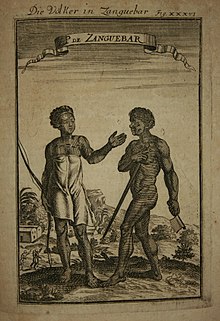
Zanzibar has been inhabited, perhaps not continuously, since thePaleolithicperiod. A 2005 excavation atKuumbi Cavein southeastern Zanzibar found heavy duty stone tools that showed occupation of the site at least 22,000 years ago.[1]Archaeological discoveries of a limestone cave usedradiocarbontechniques to prove more recent occupation, from around2800 BCto the year 1 AD (Chami 2006). Traces of the communities include objects such asglass beadsfrom around theIndian Ocean.It is a suggestion of early trans-oceanic trade networks, although some writers have expressed doubt about this possibility.
No cave sites on Zanzibar have revealed pottery fragments used by early and laterBantufarming and iron-working communities who lived on the islands (Zanzibar, Mafia) during the first millenniumAD.On Zanzibar, the evidence for the later farming and iron-working communities dating from the mid-first millennium AD is much stronger and indicates the beginning of urbanism there when settlements were built with mud-timber structures (Juma 2004). This is somewhat earlier than the existing evidence for towns in other parts of theSwahili Coast,given as the 9th century AD. The first permanent residents of Zanzibar seem to have been the ancestors of theHadimuandTumbatu,who began arriving from the African Great Lakes mainland around 1000 AD. They had belonged to variousBantuethnic groups from the mainland, and on Zanzibar they lived in small villages and failed to coalesce to form larger political units. Because they lacked central organization, they were easily subjugated by outsiders.
Early Trade Routes[edit]
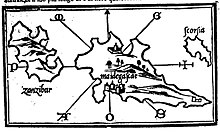

Ancient pottery demonstrates existing trade routes with Zanzibar as far back as the ancientSumerandAssyria.[2] An ancient pendant discovered nearEshnunnadated ca. 2500-2400 BC. has been traced tocopalimported from the Zanzibar region.[3]
Traders fromArabia(mostlyYemen), thePersian Gulfregion ofIran(especiallyShiraz), andwest Indiaprobably visited Zanzibar as early as the 1st century AD, followed by Somalis during the Middle Ages with the emergence of Islam. They used themonsoonwinds to sail across the Indian Ocean and landed at the sheltered harbor located on the site of present-dayZanzibar Town.Although the islands had few resources of interest to the traders, they offered a good location from which to make contact and trade with the towns of the Swahili Coast. A phase ofurban developmentassociated with the introduction of stone material to the construction industry of the African Great Lakes littoral began from the 10th century AD.

Traders began to settle in small numbers on Zanzibar in the late 11th or 12th century,intermarryingwith the indigenous Africans. Eventually a hereditary ruler (known as theMwenyi MkuuorJumbe), emerged among theHadimu,and a similar ruler, called theSheha,was set up among theTumbatu.Neither had much power, but they helped solidify theethnic identityof their respective peoples.
The Yemenis built the earliestmosquein thesouthern hemisphereinKizimkazi,the southernmost village inUnguja.Akuficinscription on itsmihrabbears the dateAH500, i.e. 1107 AD.[4]
Villages were also present in which lineage groups were common.[citation needed]
Portuguese rule[edit]
Vasco da Gama's visit in 1499 marked the beginning of European influence. In 1503 or 1504, Zanzibar became part of thePortuguese Empirewhen Captain Ruy Lourenço Ravasco Marques landed and demanded and received tribute from the sultan[who?]in exchange for peace.[5]Zanzibar remained a possession of Portugal for almost two centuries.
Zanzibar Sultanate[edit]

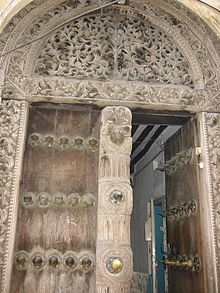
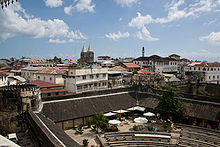
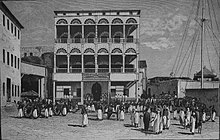


In 1698, Zanzibar fell under the control of theSultan of Oman.The Portuguese were expelled and a lucrative trade in slaves (started decades earlier by the Portuguese to supply the West Indies), and ivory thrived, along with an expandingplantation economycentring on cloves. With an excellent harbor and no shortage of fresh water, Stone Town (capital of Zanzibar) became one of the largest and wealthiest cities in East Africa. Under Omani rule, all of the most fertile land was handed over to Omani aristocrats who enslaved the farmers who worked the land. Every year, hundreds of dhows would sail across the Indian Ocean from Arabia, Persia and India with the monsoon winds blowing in from the northeast, bringing iron, cloth, sugar and dates. When the monsoon winds shifted to the southwest in March or April, the traders would leave, with their ships packed full of tortoiseshell, copal, cloves, coir, coconuts, rice, ivory, and slaves.[6] The Arabs established garrisons at Zanzibar,Pemba,andKilwa.The height of Arab rule came during the reign of SultanSeyyid Said(more fully, Sayyid Said bin Sultan al-Busaid), who in 1840 moved his capital fromMuscat, Oman,toStone Town.He established a ruling Arab elite and encouraged the development of clove plantations, usingthe island's slave labour.Zanzibar's commerce fell increasingly into the hands of traders from theIndian subcontinent,whom Said encouraged to settle on the island. After his death in 1856, his sons struggled over thesuccession.On April 6, 1861, Zanzibar and Oman were divided into two separateprincipalities.Sayyid Majid bin Said Al-Busaid(1834/5–1870), his sixth son, became theSultan of Zanzibar,while the third son,Sayyid Thuwaini bin Said al-Said,became the Sultan of Oman.
Accounts by visitors to Zanzibar often emphasize the outward beauty of the place. The British explorerRichard Francis Burtondescribed Zanzibar in 1856 as: "Earth, sea and sky, all seemed wrapped in a soft and sensuous repose...The sea of purist sapphire, which had not parted with its blue rays to the atmosphere...lay looking...under a blaze of sunshine which touched every object with a dull burnish of gold". Adding to the beauty were the gleaming white minarets of mosques and the sultan's palaces in Stone Town, making the city appear from the distance to Westerners as an "Orientalist"fantasy brought to life. Those who got closer described Stone Town as an extremely foul-smelling city that reeked of human and animal excrement, garbage and rotting corpses as garbage, sewage and bodies of animals and slaves were all left out in the open to rot. The British explorer Dr.David Livingstonewhen living in Stone Town in 1866 wrote in his diary: "The stench arising from a mile and a half or two square miles of exposed sea beach, which is the general depository of the filth of the town is quite horrible...It might be called Stinkabar rather than Zanzibar". Besides for the pervasive foul odor of Stone Town, accounts by visitors described a city full of slaves on the brink of starvation and a place where cholera, malaria, and venereal diseases all flourished.[6]
Of all the forms of economic activity on Zanzibar, slavery was the most profitable and all the blacks living on the island wereBantu peopletaken from the mainland. The slaves were brought to Zanzibar in dhows, where many as possible were packed in with no regard for comfort or safety. Many did not survive the journey to Zanzibar. Upon reaching Zanzibar, the slaves were stripped completely naked, cleaned, had their bodies covered with coconut oil, and forced to wear gold and silver bracelets bearing the name of the slave trader. At that point, the slaves were forced to march nude in a line down the streets of Stone Town guarded by loyal slaves of the slavers carrying swords or spears until someone would show interest in the procession.[7]A captain from a ship owned by the East India Company who visited Zanzibar in 1811 and witnessed these marches wrote about how a buyer examined the slaves:
The mouth and teeth are inspected, and afterwards every part of the body in succession, not even excepting the breasts, etc, of the girls, many of whom I have seen examined in the most indecent manner in the public market by the purchasers...The slave is then made to walk or run a little way to show that there is no defect about the feet; after which, if the price is agreed to, they are stripped of their finery and delivered over to their future master. I have frequently counted twenty or thirty of these files in the market at one time...Women with children newly born hanging at their breasts and others so old they can scarcely walk, are sometimes seen dragged about in this manner. They had in general a very dejected look; some groups appeared so ill fed that their bones seemed as if ready to penetrate the skin.[7]
Every year, about 40,000-50,000 slaves were taken to Zanzibar. About a third went to work on clove and coconut plantations of Zanzibar and Pemba while the rest were exported to Persia, Arabia, the Ottoman Empire and Egypt. Conditions on the plantations were so harsh that about 30% of the male slaves died every year, thus maintaining the demand for more slaves. The Omani Arabs who ruled Zanzibar had in the words of the American diplomatDonald K. Pettersona "culture of violence", where brute force was the preferred solution to problems and outlandish cruelty was a virtue. The ruling al-Busaid family was characterized by fratricidal quarrels as it was common for brother to murder brother, and this was typical of the Arab aristocracy, where it was acceptable for family members to murder one another to gain land, wealth, titles, and slaves. Visitors to Zanzibar often mentioned the "shocking brutality" which the Arab masters treated their slaves, who were so cowed into submission that there was never a slave revolt attempted on Zanzibar. The cruelty which the Arab masters treated their slaves during the period ofslavery on Zanzibarleft behind a legacy of hate, which exploded in the revolution of 1964.[7]
The Sultan of Zanzibar controlled a large portion of theAfrican Great LakesCoast, known asZanj,as well as trading routes extending much further across the continent, as far asKinduon theCongo River.In November 1886, a German-British border commission established the Zanj as a ten-nautical mile (19 km) wide strip along most of the African Great Lakes coast, stretching fromCape Delgado(now inMozambique) toKipini(now inKenya), includingMombasaandDar es Salaam,and several offshoreIndian Ocean islands.However, from 1887 to 1892, all of these mainland possessions were lost to the colonial powers of the United Kingdom,Germany,andItaly,with Britain gaining control of Mombasa in 1963.
In the late 1800s, the Omani Sultan of Zanzibar also briefly claimed to controlMogadishuin theHornand southern Somalia. However, power on the ground remained in the hands of a powerful Somali kingdom, theGeledi Sultanate(which, also holding sway over theJubba RiverandShebelleregion inSomalia's interior, was at its zenith).[8]In 1892, Geledi ruler:Osman Ahmedleased the city toItaly.The Italians eventually purchased the executive rights in 1905, and made Mogadishu the capital of the newly establishedItalian Somaliland.[9]
Zanzibar was famous worldwide for its spices and its slaves. During the 19th century, Zanzibar was known all over the world in the words of Petterson as: "A fabled land of spices, a vile center of slavery, a place of origins of expeditions into the vast, mysterious continent, the island was all these things during its heyday in the last half of the 19th century.[10]It was the main slave-trading port of the African Great Lakes region, and in the 19th century as many as 50,000 slaves were passed through the slave markets of Zanzibar each year.[11](David Livingstoneestimated that 80,000 new slaves died each year before ever reaching the island.)Tippu Tipwas the most notorious slaver, under several sultans, and also a trader, plantation owner, and governor. Zanzibar's spices attracted ships from as far away as theUnited States,which established a consulate in 1837. TheUnited Kingdom's early interest in Zanzibar was motivated by both commerce and the determination to end theZanzibar slave trade.[12]In 1822, the British signed the first of a series of treaties with Sultan Said to curb this trade. Under strong British pressure, the slave trade was officially abolished in 1876, but slavery itself remained legal in Zanzibar until 1897.[7]
Zanzibar had the distinction of having the firststeam locomotivein the African Great Lakes region, whenSultan Bargash bin Saidordered a tiny0-4-0tank engineto haul his regal carriage from town to his summer palace atChukwani.One of the most famous palaces built by the Sultans was the House of Wonders, which is today one of Zanzibar's most popular tourist attractions.
British influence and rule[edit]
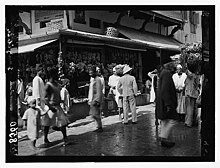
TheBritish Empiregradually took over; the relationship was formalized by the 1890Heligoland-Zanzibar Treaty,in which Germany pledged, among other things, not to interfere with British interests in Zanzibar. This treaty made Zanzibar and Pemba a Britishprotectorate(notcolony), and theCaprivi Strip(in what is nowNamibia) part ofGerman South West Africa.British rule through a sultan (vizier) remained largely unchanged.
The death ofHamad bin Thuwainion 25 August 1896 saw theKhalid bin Bargash,eldest son of the second sultan,Barghash ibn Sa'id,take over the palace and declare himself the new ruler. This was contrary to the wishes of theBritish government,which favouredHamoud bin Mohammed.This led to a showdown, later called theAnglo-Zanzibar War,on the morning of 27 August, when ships of theRoyal Navydestroyed the Beit al Hukum Palace, having given Khalid a one-hour ultimatum to leave. He refused, and at 9 am the ships opened fire. Khalid's troops returned fire and he fled to the German consulate. Acease firewas declared 45 minutes after the action had begun, giving the bombardment the title of The Shortest War in History. Hamoud was declared the new ruler and peace was restored once more. Acquiescing to British demands, he brought an end in 1897 to Zanzibar's role as a centre for the centuries-old eastern slave trade by banning slavery and freeing the slaves, compensating their owners. Hamoud's son andheir apparent,Ali,was educated in Britain.
From 1913 until independence in 1963, the British appointed their own residents (essentiallygovernors). One of the more appreciated reforms brought in by the British were the establishment of a proper sewer, garbage disposal system and burial system so that the beaches of Zanzibar reeked no more of bodies, excrement and garbage, finally eliminating the foul smell of Stone Town, which had repulsed so many Western visitors.[13]
Independence and revolution[edit]
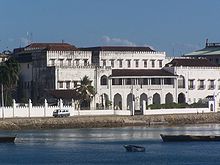
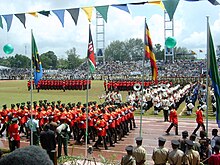
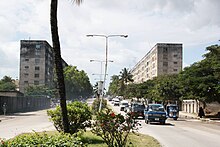
On 10 December 1963, Zanzibar received its independence from the United Kingdom as aconstitutional monarchyunder the Sultan. This state of affairs was short-lived, as the Sultan and the democratically elected government were overthrown on 12 January 1964 in theZanzibar Revolutionled byJohn Okello,aUgandancitizen who organized and led the revolution with his followers on the island. SheikhAbeid Amani Karumewas named president of the newly createdPeople's Republic of Zanzibar.Several thousand ethnic Arab (5,000-12,000 Zanzibaris of Arabic descent) and Indian civilians were murdered and thousands more detained or expelled, their property either confiscated or destroyed. The filmAfrica Addiodocuments the violence and massacre of unarmed ethnic Arab civilians.
The revolutionary government nationalized the local operations of the two foreign banks in Zanzibar,Standard BankandNational and Grindlays Bank.These nationalized operations may have provided the foundation for the newly createdPeoples Bank of Zanzibar.Jetha Lila,the one locally owned bank in Zanzibar, closed. It was owned by Indians and although the revolutionary government of Zanzibar urged it to continue functioning, the loss of its customer base asIndiansleft the island made it impossible to continue.
One of the main impacts of the revolution in Zanzibar was to break the power of the Arab/Asian ruling class, who had held it for around 200 years.[14][15]Despite the merger with Tanganyika, Zanzibar retained aRevolutionary CouncilandHouse of Representativeswhich was, until 1992, run on aone-party systemand has power over domestic matters.[16]The domestic government is led by thePresident of Zanzibar,Karume being the first holder of this office. This government used the success of the revolution to implement reforms across the island. Many of these involved the removal of power from Arabs. The Zanzibar civil service, for example, became an almost entirely African organisation, and land was redistributed from Arabs to Africans.[14]The revolutionary government also instituted social reforms such as free healthcare and opening up the education system to African students (who had occupied only 12% of secondary school places before the revolution).[14]
The government sought help from the Soviet Union, the German Democratic Republic (GDR), and P. R. China for funding for several projects and military advice.[14]The failure of several GDR-led projects including the New Zanzibar Project, a 1968urban redevelopment schemeto provide new apartments for all Zanzibaris, led to Zanzibar focussing on Chinese aid.[17][18]The post-revolution Zanzibar government was accused of draconian controls on personal freedoms and travel and exercisednepotismin appointments to political and industrial offices, the new Tanzanian government being powerless to intervene.[19][20]Dissatisfaction with the government came to a head with the assassination of Karume on 7 April 1972, which was followed by weeks of fighting between pro and anti-government forces.[21]Amulti-party systemwas eventually established in 1992, but Zanzibar remains dogged by allegations of corruption andvote-rigging,though the2010 general electionwas seen to be a considerable improvement.[16][22][23]
The revolution itself remains an event of interest for Zanzibaris and academics. Historians have analysed the revolution as having a racial and a social basis with some stating that the African revolutionaries represent theproletariatrebelling against the ruling and trading classes, represented by the Arabs and South Asians.[24]Others discount this theory and present it as a racial revolution that was exacerbated by economic disparity between races.[25]
Within Zanzibar, the revolution is a key cultural event, marked by the release of 545 prisoners on its tenth anniversary and by a military parade on its 40th.[26]Zanzibar Revolution Day has been designated as a public holiday by the government of Tanzania; it is celebrated on 12 January each year.[27]
Union with Tanganyika[edit]


On 26 April 1964, the mainland colony ofTanganyikaunited with Zanzibar to form theUnited Republic of Tanganyika and Zanzibar;this lengthy name was compressed into aportmanteau,the United Republic ofTanzania,on 29 October 1964. After unification, local affairs were controlled by PresidentAbeid Amani Karume,while foreign affairs were handled by the United Republic inDar es Salaam.Zanzibar remains a semi-autonomous region of Tanzania.
The autonomous status of Zanzibar is viewed as comparable toHong Kongas suggested by some scholars, and being recognized as the "African Hong Kong".[28]
TheZanzibar House of Representativeswas established in 1980. Prior to this, theRevolutionary Councilheld both the executive and legislative functions for 16 years following theZanzibar Revolutionin 1964.[29]
21st century[edit]
There are many political parties in Zanzibar, but the most popular parties are theChama Cha Mapinduzi(CCM) and theCivic United Front(CUF). Since the early 1990s, the politics of the archipelago have been marked by repeated clashes between these two parties. The results of the past elections held under the multiparty system are as follows:[30]
| Political Party | ElectionYear | |||||||
|---|---|---|---|---|---|---|---|---|
| 1995 | 2000 | 2005 | ||||||
| Chama Cha Mapinduzi(CCM) | 26 | 34 | 30 | |||||
| Civic United Front(CUF) | 24 | 16 | 19 | |||||
| Total | 50 | 50 | 50 | |||||
Contested elections in October 2000 led to a massacre on 27 January 2001 when, according toHuman Rights Watch,the army and police shot into crowds of protestors, killing at least 35 and wounding more than 600. Those forces, accompanied by ruling party officials and militias, also went on a house-to-house rampage, indiscriminately arresting, beating, and sexually abusing residents. Approximately 2,000 temporarily fled to Kenya.[31]
Violence erupted again afteranother contested electionon 31 October 2005, with the CUF claiming that its rightful victory had been stolen from it. Nine people were killed.[32][33]
Following 2005, negotiations between the two parties aiming at the long-term resolution of the tensions and a power-sharing accord took place, but they suffered repeated setbacks. The most notable of these took place in April 2008, when the CUF walked away from the negotiating table following a CCM call for a referendum to approve of what had been presented as a done deal on the power-sharing agreement.[34]
In November 2009, the then-president of Zanzibar,Amani Abeid Karume,met with CUF secretary-generalSeif Sharif Hamadat the State House to discuss how to save Zanzibar from future political turmoil and to end the animosity between them.[35]This move was welcomed by many, including the United States.[36]It was the first time since themulti-party systemwas introduced in Zanzibar that the CUF agreed to recognize Karume as the legitimate president of Zanzibar.[35]
A proposal to amend Zanzibar's constitution to allow rival parties to form governments of national unity was adopted by 66.2 percent of voters on 31 July 2010.[37]
Nowadays,TheAlliance for Change and Transparency-Wazalendois(ACT-Wazalendo) is considered the main opposition political party of semi-autonomous Zanzibar. The constitution of Zanzibar requires the party that comes in second in the polls to join a coalition with the winning party. ACT-Wazalendo joined a coalition government with the islands’ ruling party Chama Cha Mapinduzi in December 2020 after Zanzibar disputedelections.[38]
Lists of rulers[edit]
Sultans of Zanzibar[edit]
- Majid bin Said(1856–1870)
- Barghash bin Said(1870–88)
- Khalifah bin Said(1888–90)
- Ali bin Said(1890–93)
- Hamad bin Thuwaini(1893–96)
- Khalid bin Barghash(1896)
- Hamud bin Muhammed(1896–1902)
- Ali bin Hamud(1902–11; abdicated)
- Khalifa bin Harub(1911–60)
- Abdullah bin Khalifa(1960–63)
- Jamshid bin Abdullah(1963–64)
Viziers[edit]
- Sir Lloyd William Matthews(1890 to 1901)
- A.S. Rogers(1901 to 1906)
- Arthur Raikes(1906 to 1908)
- Francis Barton(1906 to 1913)
British residents[edit]
- Francis Pearce(1913 to 1922)
- John Sinclair,m (1922 to 1923)
- Alfred Hollis(1923 to 1929)
- Richard Rankine(1929 to 1937)
- John Hall(1937 to 1940)
- Henry Pilling(1940 to 1946)
- Vincent Glenday,1946 to 1951
- John Rankine(1952 to 1954)
- Henry Steven Potter(1955 to 1959)
- Arthur George Mooring(1959 to 1963)
See also[edit]
References[edit]
- ^"Excavations at Kuumbi Cave on Zanzibar 2005",The African Archaeology Network: Research in Progress,Paul Sinclair (Uppsala University), Abdurahman Juma, Felix Chami, 2006
- ^Ingrams, William Harold (1967).Zanzibar, its history and its people.Routledge. pp. 43–46.ISBN0-7146-1102-6.
- ^Meyer, Carol; Joan Markley Todd; Curt W. Beck (1991). "From Zanzibar to Zagros: A Copal Pendant from Eshnunna".Journal of Near Eastern Studies.50(4): 289–298.doi:10.1086/373516.JSTOR545490.S2CID161728895.
- ^Fay, Robert (2005-04-07), "Swahili People",African American Studies Center,Oxford University Press,doi:10.1093/acref/9780195301731.013.43544,ISBN978-0-19-530173-1
- ^Ingrams, W. H. (1 June 1967).Zanzibar: Its History and Its People.Psychology Press.ISBN9780714611020– via Google Books.
- ^abPetterson, Donald,Revolution In Zanzibar An American's Cold War Tale.New York: Westview, 2002. pp. 6-8.
- ^abcdPetterson, pages 23-24.
- ^Lewis, I. M. (1988).A Modern History of Somalia: Nation and State in the Horn of Africa.Westview Press. p. 38.ISBN978-0-8133-7402-4.
- ^Hamilton, Janice (1 January 2007).Somalia in Pictures.Twenty-First Century Books. p. 28.ISBN978-0-8225-6586-4.
- ^Petterson, page 4
- ^National Geographic article
- ^Remembering East African slave raidsBBC
- ^Petterson, DonaldRevolution In Zanzibar An American Cold War's Tale,New York: Westview, 2002 page 7.
- ^abcdTriplett 1971,p. 612
- ^Speller 2007,p. 1
- ^abSadallah, Mwinyi (23 January 2006),"Revert to single party system, CUF Reps say",The Guardian,archived fromthe originalon 2 August 2007,retrieved14 April2009.
- ^Myers 1994,p. 453
- ^Triplett 1971,p. 613
- ^Triplett 1971,p. 614
- ^Triplett 1971,p. 616
- ^Said, Salma (8 April 2009),"Thousand attend Karume memorial events in Zanzibar",The Citizen, Tanzania,retrieved14 April2009[permanent dead link].
- ^Freedom House(2008),Freedom in the World – Tanzania,retrieved5 April2012
- ^Freedom House(2011),Freedom in the World – Tanzania,retrieved5 April2012
- ^Kuper 1971,pp. 87–88
- ^Kuper 1971,p. 104
- ^Kalley, Schoeman & Andor 1999,p. 611
- ^Commonwealth Secretariat(2005),Tanzania,archived fromthe originalon 1 December 2008,retrieved10 February2009
- ^Simon Shen,One country, two systems: Zanzibar,Ming Pao Weekly, Sep 2016.
- ^"History of the ZHoR".Zanzibar House of Representatives.Retrieved15 November2014.
- ^"Elections in Zanzibar".Retrieved15 November2014.
- ^"Tanzania: Zanzibar Election Massacres Documented".Human Rights Watch. 10 April 2002.Retrieved27 August2010.
- ^"Nine killed in Zanzibar election violence",Seattle Times,reported by Chris Tomlinson, The Associated Press, 1 November 2005Archived6 October 2014 at theWayback Machine
- ^"karelprinsloo karel prinsloo".karelprinsloo karel prinsloo.
- ^"Tanzanian Affairs » ZANZIBAR – A BIG DISAPPOINTMENT".
- ^ab"Karume: No elections next year in Zanzibar if…", Zanzibar Institute for Research and Public Policy, reported by Salma Said, reprinted from an original article inThe Citizen,19 November 2009
- ^"Welcome to VPP Zanzibar, Tanzania".United States Virtual Presence Post.U.S. Department of State.Archived fromthe originalon 2011-02-03.Retrieved27 August2010.
- ^"Zanzibar: 2010 Constitutional referendum results"Archived2016-01-05 at theWayback Machine,Electoral Institute for the Sustainability of Democracy in Africa, updated August 2010.
- ^"Zanzibar's opposition party to join coalition government".Associated Press.6 December 2020.
Sources[edit]
- Kalley, Jacqueline Audrey; Schoeman, Elna; Andor, Lydia Eve (1999),Southern African Political History,Greenwood Publishing Group,ISBN978-0-313-30247-3.*Kuper, Leo (1971), "Theories of Revolution and Race Relations",Comparative Studies in Society and History,13(1): 87–107,doi:10.1017/S0010417500006125,JSTOR178199,S2CID145769109.
- Myers, Garth A. (1994), "Making the Socialist City of Zanzibar",Geographical Review,84(4): 451–464,doi:10.2307/215759,JSTOR215759.
- Petterson, D. (2002)Revolution In Zanzibar: An American's Cold War Tale,New York: Westview.ISBN0813342686
- Speller, Ian (2007),"An African Cuba? Britain and the Zanzibar Revolution, 1964.",Journal of Imperial and Commonwealth History,35(2): 1–35,doi:10.1080/03086530701337666,S2CID159656717.
- Triplett, George W. (1971), "Zanzibar: The Politics of Revolutionary Inequality",The Journal of Modern African Studies,9(4): 612–617,doi:10.1017/S0022278X0005285X,JSTOR160218,S2CID153484206.
External links[edit]
- Excerpt from:Race, Revolution and the Struggle for Human Rights in Zanzibarby Thomas Burgess
- Edward Steere(1869),Some account of the town of Zanzibar(1st ed.), London: Charles Cull,WikidataQ19046291


